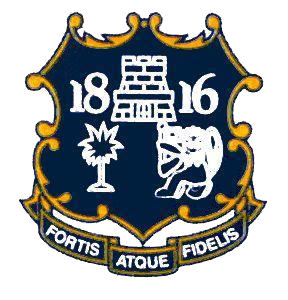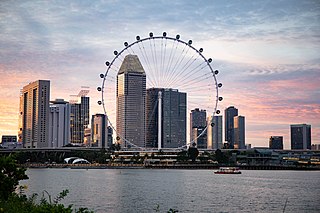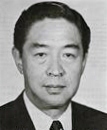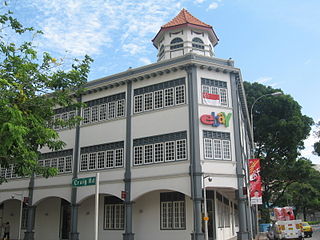
Penang Free School (PFS), located at Green Lane in George Town, Penang, Malaysia, is the oldest English-medium school in Southeast Asia. Founded in 1816, its academic achievements lead to its inclusion in the Malaysian Ministry of Education's Cluster School and High Performance School systems.

Benjamin Henry Sheares was a Singaporean physician and academic who served as the second president of Singapore from 1971 until his death in 1981. Of Eurasian descent, Sheares was born in Singapore under British rule and graduated from the King Edward VII College of Medicine. He studied obstetrics and gynaecology and worked as an obstetrician at the Kandang Kerbau Hospital (KKH), eventually serving as the Acting Professor of Obstetrics and Gynaecology at the University of Malaya in Singapore. He later became the Professor of Obstetrics and Gynaecology at the university, a rare feat for a local as usually high-ranking colonial officers held such positions.

Victoria School (VS) is a government autonomous boys' secondary school in Siglap, Singapore. The school has a hostel. Established in 1876, it is Singapore's second oldest state secondary school.

The Istana is the official residence and office of the president of Singapore. The palace is open to the public during scheduled public holidays and is where the president receives and entertains state guests.
Yusof bin Ishak was a Singaporean journalist and senior civil servant who served as the first president of Singapore between 1965 and 1970. His portrait appears on the Singapore Portrait Series currency notes introduced in 1999.

This article shows the notable future developments in Singapore. Most of them are currently under construction with most to be completed within the next five years.

Yeoh Ghim Seng was a Singaporean politician who served as Speaker of the Parliament of Singapore between 1970 and 1988.

The Singapore Conference Hall, formerly the Singapore Conference Hall and Trade Union House, is a multipurpose building in Shenton Way, Singapore. Designed in modernist style, the SCH is five stories tall and capped with a cantilevered V-shaped roof. The SCH houses the Singapore Chinese Orchestra (SCO); the concert hall has a capacity of 831 people. It was the first post-colonial building to be gazetted as a national monument in Singapore.

The Old National Library Building was a historical library building at Stamford Road in the Museum Planning Area of Singapore. Originally completed in 1960, the library building was a national icon for many Singaporeans. Despite a huge groundswell of public dissent, the library was closed on 31 March 2004, and was demolished in July that year to make way for the construction of the Fort Canning Tunnel to ease road traffic to the city. The controversy surrounding the building's demise has been credited for sparking greater awareness of local cultural roots and an unprecedented wave in favour of heritage conservation among Singaporeans.

The Singapore Badminton Stadium, formerly Singapore Badminton Hall, is a indoor sports hall for badminton located on Guillemard Road in Geylang, Singapore.
Noor Aishah binti Mohammad Salim is the widow of former President, Yusof Ishak.
Selegie House is a public housing complex which includes blocks 8-10 along Selegie Road in Singapore.

Bukit Brown Cemetery, also known as the Bukit Brown Municipal Cemetery or the Bukit Brown Chinese Cemetery, is a cemetery in Novena, Singapore. Located in the Central Region of Singapore, the land where the cemetery sits was originally owned by George Henry Brown, a British merchant. Due to its hilly terrain, the land became known as Brown's Hill, which was translated locally in Malay to Bukit Brown.

Ng Keng Siang was a pioneering Singaporean architect. He designed several buildings which have since become local landmarks, including the Asia Insurance Building, which was the tallest structure in Singapore at its completion, and the Nanyang University. He was the founding president of the Society of Malayan Architects.

60 Waterloo Street is a historic bungalow on Waterloo Street in downtown Singapore. A second four-storey building was constructed behind the bungalow when the Dance Ensemble Singapore moved into the bungalow in 1995.

Eng Aun Tong Building, also known as Tiger Balm Medical Hall, is a historic building at the corner of Neil Road and Craig Road in Tanjong Pagar, Singapore. Completed in the 1920s, it served as the Tiger Balm factory for several decades.

Wong Lin Ken was a Singaporean politician and historian. He served as the first Ambassador of Singapore to the United States. A member of the People's Action Party (PAP), Wong also served as the Minister for Home Affairs from 1970 to 1972 and the Member of Parliament (MP) representing Alexandra Constituency from 1968 to 1976.
Sophia Flats is a condominium on Wilkie Road in Rochor, Singapore. The building, which was completed in 1920, has been gazetted for conservation.

Maxwell Chambers Suites, formerly known as the Traffic Police Headquarters or the Traffic Police Building, and later as the Red Dot Traffic Building, is a historic building on Maxwell Road in Chinatown, Singapore. It initially served as the Police Barracks and the headquarters of the Traffic Police branch of the Singapore Police Force, which moved into the building in 1930. In 1941, the first driving test centre in Singapore was established within the building. It ceased operations in 1978 to relieve congestion in the area.
















